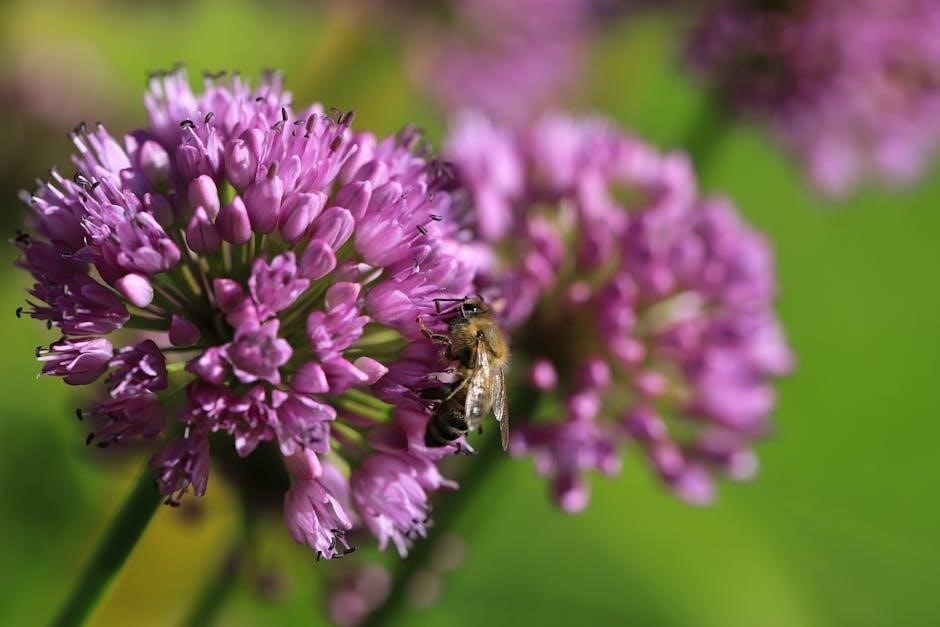In “The Flower” by Alice Walker, ten-year-old Myop experiences a life-changing discovery while picking flowers in rural Georgia, marking the end of her childhood innocence and revealing harsh realities of racial violence and death.
Background of the Book “Love and Trouble: Stories of Black Women”
Love and Trouble: Stories of Black Women is a collection of short stories by Alice Walker, published in 1973. This anthology explores themes of race, gender, and personal identity, offering a poignant portrayal of the African American experience. Walker’s prose is both lyrical and concise, capturing the raw emotions and struggles of her characters. The book delves into the complexities of black women’s lives, addressing issues such as racial tensions, societal expectations, and individual resilience. Through her stories, Walker provides a voice for women often marginalized in society, creating a powerful narrative that resonates deeply. Love and Trouble is celebrated for its unflinching honesty and its ability to illuminate the human condition. The collection includes works like The Flowers, which stands out for its vivid imagery and emotional depth. Overall, the book is a significant contribution to African American literature, showcasing Walker’s ability to weave compelling stories that challenge and inspire readers.
Myop’s Character: The Young Protagonist
Myop is the young protagonist of Alice Walker’s short story The Flowers. She is a ten-year-old African American girl who embodies innocence and curiosity. Myop’s name, which is short for “Myopia,” suggests her limited vision of the world around her. Through her character, Walker portrays the typical carefree nature of childhood, where the world seems full of beauty and wonder. Myop’s interactions with nature, such as picking flowers and exploring her surroundings, highlight her connection to the natural world and her sense of joy. However, her discovery of the lynched man’s remains marks a turning point in her character development, forcing her to confront harsh realities. Despite this, Myop’s demeanor remains calm and almost detached, showcasing her youth and naivety. Her character serves as a symbol of innocence and the abrupt loss of childhood in the face of racial violence and societal brutality. Through Myop, Walker explores themes of growth, awareness, and the impact of traumatic experiences on young minds.

Plot Summary: A Journey of Innocence and Discovery
Alice Walker’s The Flowers follows the journey of Myop, a young African American girl, as she experiences a transformative day in rural Georgia. The story begins with Myop skipping through the family farm, enjoying the beauty of nature and the vibrant flowers she collects. Her carefree spirit is evident as she explores the surroundings, unaware of the harsh realities that await her. While wandering near the spring, she discovers a decomposed skeleton, later revealed to be the remains of a lynched African American man. The story takes a dark turn as Myop uncovers a rotted noose and a frayed plowline, symbols of racial violence and oppression. Despite this gruesome discovery, Myop remains surprisingly composed, reflecting her youth and innocence. The narrative contrasts the idyllic summer day with the grim truth of racial brutality, culminating in Myop laying down her flowers, symbolizing the end of her childhood. Walker’s concise yet powerful storytelling highlights the abrupt loss of innocence and the profound impact of racial violence on a young mind.

Themes in “The Flower”
The Flower by Alice Walker explores themes of loss of innocence, racial violence, and coming of age. It highlights the harsh realities of racial oppression and the abrupt end of childhood innocence through Myop’s discovery of a lynched man’s remains.
5.1 Loss of Innocence
The theme of loss of innocence is central to Alice Walker’s The Flower. Myop, a carefree and curious ten-year-old, experiences a dramatic shift in her perception of the world when she discovers the decomposed remains of a lynched African American man. This moment marks the end of her childhood innocence, as she confronts the brutal reality of racial violence and death. The story juxtaposes the beauty of nature, symbolized by the flowers she collects, with the ugliness of human cruelty, represented by the noose and the skeleton. Myop’s detachment from the horror, as she continues to pick flowers, underscores the abrupt and irreversible loss of her innocence. Walker uses this moment to highlight how societal evils can shatter the purity of childhood, forcing young individuals to confront harsh truths prematurely. The story serves as a poignant critique of racial oppression and its impact on the innocent, leaving a lasting impression on readers about the fragility of youth and the darkness of the world.
5.2 Racial Violence and Its Impact
Racial violence and its impact are powerfully depicted in Alice Walker’s The Flower. The discovery of the lynched man’s remains serves as a stark reminder of the systemic racism and brutality faced by African Americans in the Deep South. This incident, though seemingly subtle in its presentation, carries profound weight in illustrating the pervasive fear and violence that shaped the lives of Black individuals during this era. The noose, a symbol of racial oppression, underscores the historical context of lynching as a tool of terror and control. Myop’s encounter with this grim reality not only shocks her but also reflects the broader societal issue of racial injustice. Walker’s portrayal of this event highlights how such violence dehumanizes both the victim and the perpetrator, leaving a lasting scar on communities. The story emphasizes the enduring impact of racial violence on individuals and society, serving as a critique of the deep-seated prejudices that perpetuate inequality. Through this narrative, Walker sheds light on the historical and emotional toll of racism, making it a significant theme in the story.
5.3 Coming of Age in a Harsh Reality
In “The Flower” by Alice Walker, Myop’s journey symbolizes a abrupt transition from childhood innocence to the harsh realities of adulthood. While gathering flowers, her discovery of a lynched man’s remains shatters her naive worldview, exposing her to the brutal truth of racial violence. This moment marks her coming of age, as she confronts the grim realities of death and injustice. The contrast between her carefree flower-gathering and the gruesome find underscores the sudden loss of innocence. The noose, a haunting symbol of racial oppression, serves as a stark reminder of the violent history endured by African Americans in the Deep South. Myop’s emotional detachment from the discovery, though seemingly indifferent, reflects the numbing effect of such atrocities on a young mind. This experience reshapes her understanding of the world, revealing the harsh truths of racial violence and its enduring impact on her community. Through Myop’s story, Walker vividly portrays how such encounters force African American youth to confront the cruel realities of their world, accelerating their transition into adulthood.

Symbolism in the Story
The Flower by Alice Walker is rich in symbolism. The flowers represent life, beauty, and innocence, while the noose symbolizes racial violence and oppression. The setting reflects Myop’s harsh reality, blending natural beauty with the ugliness of death and injustice.
6.1 Flowers as Symbols of Life and Death
The flowers in Alice Walker’s The Flower serve as powerful symbols, representing both life and death. Initially, they embody the vibrant beauty of nature, reflecting Myop’s innocent and carefree spirit. The variety of flowers, such as the wild pink rose, symbolize the joy and simplicity of childhood. However, their significance shifts dramatically when Myop discovers the decomposed body. The flowers she gathers, once a symbol of life, now juxtapose the grim reality of death, highlighting the loss of innocence. The wild pink rose, in particular, becomes a poignant symbol as it grows near the remains of the lynched man, blending life and death in a haunting way. This duality underscores the story’s themes of innocence shattered by the harsh realities of racial violence and mortality. Through the flowers, Walker masterfully conveys the contrast between the beauty of nature and the ugliness of human cruelty, creating a lasting emotional impact on the reader.
6.2 The Noose: A Symbol of Racial Oppression
The noose in Alice Walker’s The Flower is a chilling symbol of racial oppression and violence. When Myop discovers the frayed plowline tied to an overhanging oak limb, it evokes the brutal history of lynching in the Deep South. The noose, now weathered and blending into the natural surroundings, represents the normalized violence against African Americans during the era. Its presence near the decomposed body underscores the systemic racism that perpetuated such atrocities. The noose serves as a stark reminder of the fear and terror imposed on Black communities, contrasting sharply with the idyllic setting of the rural landscape. Walker uses this symbol to highlight the pervasive nature of racial violence, which intrudes even into the innocence of childhood. The noose’s subtle yet powerful presence in the story underscores the historical and cultural context of racial oppression, making it a haunting and unforgettable element of the narrative.
6.3 The Setting: A Reflection of the Character’s World

The rural Georgia setting in Alice Walker’s The Flower mirrors Myop’s world, blending beauty with underlying darkness. The story unfolds in a picturesque landscape of silver ferns, wildflowers, and a babbling spring, which initially seem idyllic. However, this serene backdrop contrasts with the harsh realities Myop encounters, such as the pigs rooting in the soil and the eventual discovery of the decomposed body; The setting reflects Myop’s innocence and her connection to nature, while also hinting at the racial tensions and violence that permeate her environment. The fence, the spring, and the oak tree serve as key elements that guide Myop’s journey, symbolizing her transition from childhood to a harsher understanding of the world. Walker’s vivid descriptions of the setting create a sense of intimacy and immediacy, drawing readers into Myop’s experience. The interplay between the natural beauty and the disturbing elements of the setting underscores the duality of Myop’s world, where innocence coexists with the brutal truths of racial oppression.
Setting: Time and Place
The story is set in rural Georgia during the post-Civil War era, reflecting the racial tensions and social injustices of the Deep South. The idyllic countryside contrasts with the harsh realities of lynching and oppression, shaping Myop’s world.
7.1 Rural Georgia: TheBackdrop of the Story
Rural Georgia serves as the vivid backdrop of “The Flower,” where the natural beauty of the countryside juxtaposes the harsh realities of racial violence. The story unfolds in a rural setting, where Myop’s family lives in a sharecropper cabin, surrounded by fields and forests. The landscape is described as idyllic, with elements like silver ferns, wildflowers, and a spring that provides drinking water, creating a sense of tranquility. However, this serene environment is disrupted by the discovery of a lynched man’s remains, highlighting the brutal undercurrents of racial oppression in the rural South. The setting not only reflects the characters’ daily lives but also underscores the historical context of racial tensions and violence prevalent in Georgia during the early 20th century. Walker’s depiction of rural Georgia emphasizes the contrast between the beauty of nature and the ugliness of human actions, making it a pivotal element in the story’s narrative.
7.2 Historical Context: The Deep South and Racial Tensions
The story “The Flower” by Alice Walker is set against the backdrop of the Deep South, a region marked by a history of racial violence and oppression. The discovery of the lynched man’s remains underscores the pervasive racial tensions of the time, reflecting the brutal realities faced by African Americans in rural Georgia. The setting evokes the era of segregation and the lingering effects of slavery, where racial violence was both a tool of control and a manifestation of deep-seated hatred. Walker’s narrative subtly yet powerfully captures the fear and trauma embedded in the lives of Black communities, highlighting the systemic racism that permeated every aspect of life in the South. The historical context of racial violence and inequality is central to the story, as it provides a stark contrast to the innocence and beauty of Myop’s childhood, ultimately shattering her illusions about the world. This backdrop is essential to understanding the story’s themes of loss, violence, and the harsh realities of growing up in a racially divided society.

Alice Walker’s Writing Style: Lyrical and Concise
Alice Walker’s writing style in “The Flower” is characterized by its lyrical and concise nature, creating a vivid yet understated narrative. She employs poetic language to describe Myop’s surroundings, infusing the natural setting with a sense of beauty and tranquility; Walker’s use of short, impactful sentences contributes to the story’s emotional intensity, allowing the reader to grasp the gravity of Myop’s discovery without overt dramatization. Her prose is both simple and profound, capturing the innocence of childhood while subtly weaving in the harsh realities of racial violence. The juxtaposition of Myop’s carefree exploration of nature with the grim finding of the lynched man’s remains is a testament to Walker’s ability to balance delicacy with depth. This stylistic choice enhances the story’s emotional resonance, making it a powerful exploration of loss and innocence. Walker’s concise yet evocative writing ensures that the narrative remains both accessible and deeply moving, leaving a lasting impression on the reader.

Feminist Approach: Analyzing Myop’s Experience
A feminist approach to “The Flower” by Alice Walker reveals Myop’s journey as a reflection of societal expectations and gender roles. Myop, a young black girl, embodies innocence and curiosity, but her encounter with the lynched man’s remains shatters her naivety, symbolizing the harsh realities imposed on women. Walker portrays Myop’s character to highlight the premature loss of innocence experienced by black girls, forced to confront the violence and oppression that permeate their world. The discovery serves as a metaphor for the systemic violence faced by black communities, illustrating the normalization of such atrocities in Myop’s environment. Despite this trauma, Myop’s resilience is evident as she continues her routine, showcasing a form of resistance and survival. This narrative underscores feminist themes of endurance and survival, emphasizing how black women navigate and endure oppressive systems. Walker’s portrayal of Myop’s strength and resilience aligns with feminist ideals, highlighting the capacity to endure and survive despite overwhelming adversity. Through Myop’s experience, Walker critiques the societal expectations and violence that shape the lives of black women, offering a powerful feminist critique of race and gender intersecting in a oppressive society.

Cultural Significance of the Story
“The Flower” by Alice Walker holds profound cultural significance, reflecting the African American experience of racial violence and loss of innocence. It critiques systemic oppression, offering a poignant commentary on the Deep South’s historical tensions and their lasting impact.
10.1 The African American Experience
Alice Walker’s “The Flower” profoundly reflects the African American experience, particularly the harsh realities of racial violence and systemic oppression in the Deep South. The story captures the innocence of childhood shattered by the brutal discovery of a lynched man, symbolizing the broader societal injustices faced by African Americans. Myop’s journey mirrors the collective trauma of a community subjected to racial terrorism, highlighting the emotional and psychological toll of such violence.
The narrative also underscores the resilience and strength of African American individuals and communities in the face of oppression. Through Myop’s character, Walker portrays the duality of life—beauty and horror coexisting in a world fraught with racial tensions. The story serves as a powerful critique of the historical and cultural context that perpetuated such violence, offering a poignant commentary on the African American experience during this period.

Ultimately, “The Flower” is a testament to the enduring impact of racial violence on individuals and communities, making it a significant work in the literature addressing the African American experience. Its cultural relevance lies in its ability to evoke both sorrow and reflection, inviting readers to confront the darker aspects of history and their lingering effects.
Reception and Impact of the Story

Alice Walker’s “The Flower” has received significant critical acclaim for its powerful and poignant portrayal of racial violence and its impact on a young African American girl. The story’s concise yet profound narrative has made it a widely studied and discussed work in literature classrooms and scholarly circles. Many critics have praised Walker’s ability to convey deep emotional and societal complexities through the innocent perspective of Myop, making the story both heartbreaking and thought-provoking.
The story’s exploration of themes such as loss of innocence, racial oppression, and the harsh realities of the Deep South has resonated with readers, sparking important discussions about race, identity, and justice. Its impact extends beyond academia, as it has influenced conversations about social justice and the representation of African American experiences in literature.
Due to its brevity and depth, “The Flower” is often included in anthologies and educational curricula, ensuring its continued relevance and reach. The story’s ability to evoke strong emotions and encourage reflection has solidified its place as a significant work in American literature, particularly in the context of African American storytelling and social justice advocacy.
Availability of “The Flower” in PDF Format
Alice Walker’s “The Flower” is widely available in PDF format for educational and personal reading purposes. The story, part of her collection Love & Trouble: Stories of Black Women, can be found on various academic and literary websites. Platforms like LitCharts and educational repositories offer free access to the PDF version, making it accessible to students and researchers. Additionally, some websites provide downloadable versions of the story, often accompanied by analysis and study guides.
However, accessing the PDF may require navigation through security measures, as some sites use protection services like Cloudflare to prevent unauthorized access. Users may need to verify their identity or use institutional access to download the file. Despite these challenges, the story’s popularity ensures its availability across multiple platforms, including online libraries and academic databases.
For those seeking a seamless reading experience, purchasing the book or accessing it through subscription-based services like JSTOR or university libraries is recommended. The PDF format allows readers to engage with the story in a convenient and portable manner, preserving the original text’s integrity and emotional impact.
